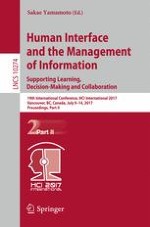The two-volume set LNCS 10273 and 10274 constitutes the refereed proceedings of the thematic track on Human Interface and the Management of Information, held as part of the 19th HCI International 2017, in Vancouver, BC, Canada, in July 2017.
HCII 2017 received a total of 4340 submissions, of which 1228 papers were accepted for publication after a careful reviewing process.
The 102 papers presented in these volumes were organized in topical sections as follows:
Part I: Visualization Methods and Tools; Information and Interaction Design; Knowledge and Service Management; Multimodal and Embodied Interaction.
Part II: Information and Learning; Information in Virtual and Augmented Reality; Recommender and Decision Support Systems; Intelligent Systems; Supporting Collaboration and User Communities; Case Studies.
